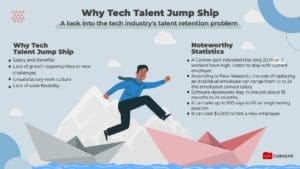
The big questions today are not just about where to find software developers and tech talent but how to effectively reel it in and keep it in your ranks. Here’s what we’ve learned from nearshoring in Mexico and building committed teams.
Losing an employee is precisely the screeching halt that you want to avoid for your company’s growing momentum. Not only does it derail your forward movement, it scatters morale, dents your resources, and puts your team in a precarious position.
There are ways to rethink job retention in light of current events and climate to improve your chances of keeping your talent around. Below are insights we’ve learned from helping companies build committed remote teams in Mexico.
What Does the Data Say Regarding Talent Retention in the Tech Industry?
Companies and hiring managers have to consider a myriad of factors and changing trends. Every industry is different. The tech industry, for example, has unique characteristics that make talent acquisition and retention particularly challenging in today’s landscape. A recent Harvard Business Review survey, for example, outlined that the talent problem is very real: only 13% of employers said they were able to hire and retain much-needed employees.
Data from 2017 showed that many software engineers jumped ship rather quickly if they were offered a better opportunity elsewhere or if they experienced boredom with their current role. HackerLife data illustrated the employee turnover rates for some of the biggest tech companies in the San Francisco Bay area. Tenures ranged from 1.3 years to 3 years at the most.
At that time, companies like Uber had an average employee tenure of 1.3 years, Twitter had 1.9, Facebook 2.2, and Netflix had the highest with 3 years. That was five years ago; the trend was already apparent. Most software engineers were leaving companies after about 2 years, even with the dazzling amenities, free meals, and meditation rooms.
Since then, the situation seems to have gotten even more critical. The tech industry is at about a turnover rate of 13.2%, which is higher than most other sectors. This is true even in big companies. For example, in 2018 Tesla saw an average tenure of about 2.1 years, Dropbox loses tech workers after about 2.1 years as well, and Uber is a little lower with about 1.8 years. In 2019, Gallup reported that the annual turnover rate in the US. was 26.3% and that the cost of replacing an individual employee could be from one-half to two times the employees annual salary.
Then, covid hit, and that started the Great Resignation, Great Reshuffling, and all the subsequent movements of quiet quitting and quiet firing and any number of fun names for the shifting workplace. By September of 2021, a Gartrner poll of executives showed that 60% were significantly concerned about keeping their employees. In 2022, work setups and dynamics have radically changed.
In many industries, but especially in tech, the bargaining power shifted from the employer to the employee.

Why Does Tech Talent Jump Ship?
In the past few years, a few things have come into the forefront as major contributors to low talent retention in the tech industry.
As we’ve seen in the tech industry, the most common reasons tech professionals leave their job are:
- Salary and benefits. While it is true that throwing money at a talent problem doesn’t always fix everything, salary and benefits continue to be at the top of considerations for IT professionals. Benefits are a big draw for workers in all industries and they have become a big bargaining chip to winning the best talent. In Mexico, IT professionals are very much concerned with having a good salary and benefits as part of their work and will often forgo working in big name companies for smaller companies offering a better salary. Despite the differences in living standards, salary expectations in Mexico and across Latin America have risen because of the state of the market and the very high demand for skilled developers and engineers.
- Work flexibility. In our tech salaries survey of IT professionals in Mexico, for example, 41% of people looking for new work cited flexible or remote work as a reason for their intended departure. Flexibility has many levels. It refers to work schedule and location, as well as some flexibility in function. Our survey indicated that almost 60% of IT professionals in Mexico see having a home office or remote work as a top choice regarding job flexibility.
- Work opportunities and job growth. This is a big one. Software engineers, developers, designers, and other IT professionals like challenges. A lack of job growth signals stagnation and this has become a major factor in people’s desire to leave. Companies should consider upskilling and training or supporting the personal growth of their employees.
Employee Retention: A Few Lessons from Nearshoring in Mexico
As an end-to-end platform for employers hiring software developers in Mexico and Latin America, we are on the front lines of both ends of this spectrum. On one end, we got boots on the ground in the Mexico tech ecosystem to scope out the best talent, tech talent hubs, and maintain a strong connection to a network of IT professionals. On the other end, we see the struggles of startups, mid-size business, and large businesses as they look to build or expand their team.
Below are a few considerations that can help you navigate the talent retention question.
#1 Dive into the Market and Industry Trends
If you run a company, you likely understand the way things are moving in your industry, but what about the labor market in your sector? What sort of things are important to them and what kinds of offers attract and keep the best talent? If you’re hiring remotely, dig deep into the talent market and get to know some of the unique aspects of it.
For example, from what we’ve seen, remote work has taken over Latin America. In contrast to the United States, where there has been a bigger push to return to the office, LATAM has big support for the home office.
The data and our network of 25,000+ developers backs up the idea that the remote model suits many in Latin America. Our last Tech Salaries Report, which detailed key insights into the Mexican IT industry indicated that 90% of the tech professionals that worked from home during the pandemic did not want to return to the office. Similarly, a report from Atlantico also outlines just how popular remote work became in Latin America.
In our experience, companies looking to nearshore to Mexico should look into the market with a ‘remote first’ mentality. That is, unless your company’s plan is to establish and build a long-term hub in Mexico, you will have a better shot at filling your positions by hiring remote developers instead of imposing in-office requirements. And if you require in-office work, then consider the job flexibility and amenities that might need to go along with the in-office requirement.
Understanding where you are sourcing talent from can give you insights as to what that talent pool expects or seeks from their employment.
#2 Consider That Tech Talent Has Unique Characteristics
The top tech talent active in some of today’s most in-demand positions, including software developers, engineers, UX/UI designers, project managers, and so forth, tend to be a problem-solving, technically-minded, and investigative group of people. Most of the people that seek out this profession are people interested in creating new technologies, solving problems, and building digital infrastructure. These professionals seek challenges, job growth, and want to feel that their input in an organization matters.
Even when working remotely, there is a major collaborative aspect to much of the work that they are doing. Companies can use these collaboration opportunities to help employees grow, integrate into the team, and learn new skills.
#3 Cultivate Company Culture
There’s that old business adage that “culture eats strategy for breakfast.” The phrase refers to two very important components of a company: culture and strategy. And, of course, the assumption is that many organizations forget about the culture and focus on the strategy without realizing that culture, in many ways, fuels the strategy. Company culture defines many things in your organization. The concept defines how an organization is run and the values and beliefs an organization shares. It is closely tied to leadership and how an organization treats their workers.
Software developers and engineers notice company culture. For growing tech talent, a company that has a strong company culture will be much harder to walk away from than one where they feel isolated and underappreciated.
Worried About Talent Retention? Nearshore in Mexico and Explore the Many Options to Building Committed Remote Teams
Companies face many challenges right now, where to find software developers and tech talent is a big one. Hiring and keeping good talent has many companies rethinking talent retention. Part of our commitment at CodersLink is providing the support to help companies find the right candidate and build robust teams.
At CodersLink, we help to build committed teams and that begins before, during, and after the hiring process. Connect with our team and learn more about what we do.


